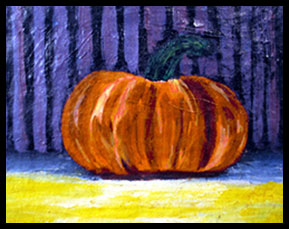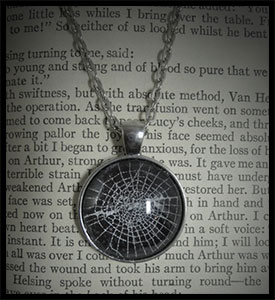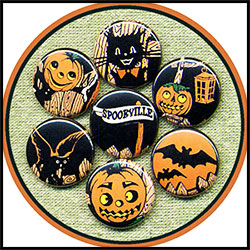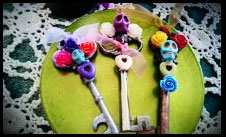
Longing for crisp Autumn evenings, warm cider and candy corns? Do Jack o lanterns and witches dance through your dreams? Can’t wait to put on your costume and celebrate Halloween? We have the remedy you need!
Spooky Cute Team and Halloween Artist Bazaar bring you Halloween In June 2015!
Search HAB Halloween on Etsy and visit the HAB catalog,
search Spooky Cute Team on Etsy to find Halloween in June!
Below you will find items for sell from members of Halloween Artist Bazaar and HAB members who also belong to Spooky Cute Team.
DANSE CALINDA!
![]()
DANSE CALINDA! -By Debbi Decker
It was June 23, 1860, St. John’s Eve, and midsummer was upon them. They could hear the drums in the distance. A secret conversation, a statement and response, the meaning of which was known only to the anointed ones. People came to the Bayou St. John, whether by foot or by train to the end of the line. It was risky to attend, though people from all walks of life would at least attempt to come. Many who came to the dance would attend in anonymity, hoping to be ridden by the spirits. Some would be baptized in the water, all would share in the sanctity of the event. The smoke of the bonfires would obscure and maintain the secrecy. If the fog rolled in off the bayou, all the better. The dark of the night, the songs, the offerings, and the dancing were all for the benefit of the Loas. If the participants were lucky, their Queen, Marie Laveau, would attend and dance amongst them, perform the rituals, and preside over the feasts.
St. John’s Eve is a Christian celebration that roughly correlates with the summer solstice in the Northern Hemisphere. Celebrated on evening of June 23, it precedes the Saint’s day, which celebrates the birth of John the Baptist on June 24, a Catholic Holy Day. The roots of this celebration date back to the early pagan summer solstice traditions. Bonfires were lit to drive away the witches that pass by during the night, and sometimes effigies were burned. Young men and women would jump the fires holding hands. Music and feasting and divination were part of the festivities. Ashes from the fires would be placed in the corners of the fields where the crops were growing to ensure further growth and plenty. Magical herbs such as St. John’s Wort were gathered, though I have yet to discover what the name of that particular herb would have been in those times (since John the Baptist is a Catholic saint). The celebration of St. John’s Eve continues today. One has only to Google the holiday to see the various ways many countries did, and still do, observe the holiday.
The brief description in the first paragraph concerns the St. John’s Eve celebration the way it would have been observed by the slaves and free people of color who held Voodoo beliefs and lived in New Orleans and surrounding areas during the 1800s. The practice of the Voodoo religion was outlawed. Voodoo, an Afro-centric religion, has always been a somewhat malleable religion. The practices were as varied as the tribes whose members were uprooted and brought to New Orleans from the different regions of Africa, and later on, from Haiti. Because the religion itself was outlawed, believers used the Catholic saints, rituals, and observances as a “cover” for their religion. Many Saints had characteristics of the Loas (the deities and ancestors) they revered, so those Saints were borrowed to stand in for the Loas. Using Catholic practices, the believers could continue to honor their ancestors, beseech the Loas for their help, and continue to use their varied knowledge of the plants, animals, and elements in their day to day life.
![]()
Voodoo in New Orleans is still practiced, and St. John’s Eve continues to be observed. Over time, Voodoo has lost much of its secrecy and has survived the horrors attributed to it by Hollywood’s depictions in the movies so many of us have watched. Baptism and head washing are two of the important elements of the observance. This ritual cleansing is to bring about renewal, good fortune, and prosperity to the person participating.
If you are interested in observing St. John’s Eve in your home, you can take a simple ritual bath using Florida water, white candles and white flowers. Play music that soothes you. Light the candles and pour of few drops of the Florida water (I can actually buy this in my local drugstore!) in your bathwater. You can either float the flowers in the water or you can set them around the bath. You may either pour the bathwater over you 7 times or you may rest in the water for a short period of time. Ask the deities to aid you in whatever path you wish to follow. Once you are done, dress all in white and go to bed for rest and rejuvenation, and hopefully, to receive the messages the ancestors have for you.
Another interesting use of water on this day is to create a protection bottle to drive away bill collectors, enemies, and the law. Assuming my readers need this. Go to a river or other body of water on St. John’s Eve and fill a small clean glass bottle with the water. I have read some versions of this spell that instructs the reader to recite the “Lord’s Prayer” while gathering the water. Personally, I don’t think that particular prayer is necessary; you could recite a prayer concerning protections that has a personal meaning to you. Seal the bottle and place it near your front door with the top of the bottle pointing towards the door. Ask the deities to aid you in keeping the undesirables away from you and your home. This bottle should never be emptied, though if contents evaporate over time you can refill it.
The bottle spell is an old spell, handed down through many generations of Voodoo practitioners. Notice the references to bill collectors, enemies, and the law. Think about how the slaves and free people of color would have lived in New Orleans during the 1800s. They were surrounded by those who would cause them harm, and the officers of law could at any time could arrest them for anything at all. Those who were free lived hand to mouth in many cases and were always on the lookout for the bill collectors that could take their money and livelihoods from them. Lastly, the recitation of the Lord’s Prayer, which is a Catholic prayer, is evidence of the use of the Catholic religion to pray to their Loas for protection and help.
So, what the heck does “danse Calinda” (the title of this article) mean? The original Calinda was a martial arts practice of stick fighting which came to the Caribbean islands in the 1700s out of the country of Kongo in Africa. Because stick fighting was not allowed by the planters of the islands, the movements were appropriated and adapted by the slaves into a type of dance. As many of the planters and their slaves came to New Orleans, the Calinda came with them, and the dance was a feature of many of the Voodoo gatherings.
St. John’s Eve is coming soon. Celebrate this day, dance like “nobody is watching”, and take that ritual bath. By the way, that “nobody is watching” part? That ain’t true. The deities and ancestors are always watching. Dance for them. Dance for you.
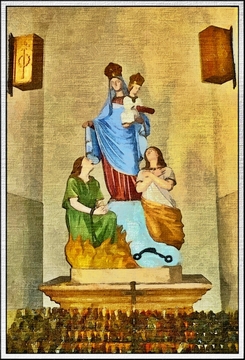
Photographs “Voodoo Window”, “Voodoo Shrine” and “Saint” provided by twistedpixelstudio and are copyrighted images. To contact Debbi Decker for purchase of these prints visit her website.
Debbi Decker is proprietor of Crazed Poppet Creations Art & Assemblage Emporium. Check out her artist page to find links to her shop and blog to read more of her writings. Visit again next month for the telling of hauntings and ghostly tales by Debbi Decker.
Archived Featured Artist: Art Enxebre
Featured Artist: Art Enxebre. Paer Mache sculpted figurines, jewelry and paintings inspired by Samhain and the ancient celtic heritage of Galicia through the talented hands of Sebastián Armesto Teixeiro.
The Boogieman and the Monster Under the Bed
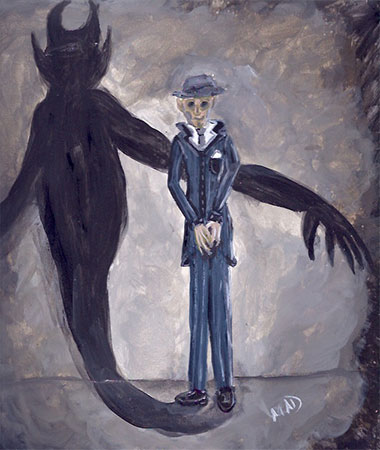
The Boogieman and the Monster Under the Bed-By Angelique Duncan
The sound in the dark, that scratching at your window, the shadow that moved in your peripheral vision; that feeling of knowing you are being watched while you lie in your bed. You call out asking who is there. There is no answer. Silence. You turn the light on and check once again. Under the bed, in the closet, peer into the corners and under the clothes in the laundry basket, nothing is there. You turn the light off and as soon as you lie back down, you feel it again. He is watching you. He is never seen and his voice is never heard, but you know he is there. He has a name; it is fear. He is the Boogieman.
Some form of Boogieman legend exists in nearly every culture and on every continent. Although his name may be different and his description varied he is intrinsically the same. He is feared. He is known as the Boogieman, boogey, Boogie Monster, Bogyman, Sack man, Booger Man, Boggart, Der Schwarze Mann, Bubak, the Bagman and a host of other names depending on where you are on the globe.
His description changes form region to region. Some believe he is a shape shifter and can take the form of any living thing, particularly animals and creatures. In most mythologies he is identified as male, although in some countries he is a she and takes a female form.
The Boogie Man has been described many different ways. He has been said to be small and hairy with deformed limbs, big red eyes with claws and sharp fang teeth. Others say he is tall, gaunt and abnormally thin. Some say he has hooved feet and devils horns. Others say he wears a dark hat and a cloak or a black hooded robe. Many legends tell of a scarecrow like figure, telling that he has a Jack o Lantern head, or no head at all. Descriptions vary from a lizard like creature to being animal like or even being seen as a demon. In each culture he takes on a different description, each more hideous and scary than the other, always somewhat humanoid yet a monster of some type and most often thought of as a shape shifter.
It is not clear where the Boogieman comes from. Some believe he originates from the warning tales of Goblins in the British Ise and stories of him migrated with the Scottish and Celts to Germany. However, some sort of established Boogieman mythology existed in every culture well before European migrations. Some believe he comes in with fog. Legends are told of a green fog associated with the Boogieman’s appearance. It is thought by many that he lives in shadows and dark dusty musky places. The Boogieman can move through houses unseen, living in basements, attics and cellars or between walls and floorboards. He can maneuver under beds, into closets and under laundry hampers undetected.
He thrives on darkness, only stalking at night and will retreat from light. He watches in the dark and waits until one is alone to terrorize. It has been told that that he will only attack those who are not asleep while other telling’s state that sleep is when he attacks. In most folklore he will only stalk one specific victim at a time and will wait until they are defenseless in bed.
Some believe he is a punisher much like Krampus, the devil like creature who disciplines naughty children during the Christmas season. In many cultures he is used as a threat by parents to children who misbehave. The concern of a visit from the Boogieman is used to curtail every offense from sucking ones thumb, not finishing ones dinner to not going to bed on time. The punishment being that the offending child will be taken away by the Boogieman at night.
Legends abound of the Boogieman hiding in shadows and snatching children and travelers who are out too late after dark. The most common folklore that appears in European, Asian and South American folklore is that he carries them away in a sack to be tortured and eaten. A legend in Czech and Polish regions claims that the Boogieman, under the name Bubak, drives a cart drawn by cats and looks for victims at night, piles them on the cart and takes them away to be skinned and fed to the cats.
Although many stories tell that the Boogieman appears as a consequence of ones actions as a disciplinarian or for being out too late, other myths tell that he picks his victims at random out of a sinister cruelty. That one never knows when or why the Boogieman will take a victim, he just does out of spite.
Theories have been told that the Boogieman is an evil spirit or an undead entity wandering the earth. Other theories say he is a demon unleashed from Hell. Stories exist that the Boogieman was a tortured and abused child who was unwanted and unloved. His parents killed him and he came back from the grave to torture and punish other children as a result. Another legend is that he preys on adults who are bad or abusive to their children as retaliation for his own parents’ misgivings. A modern explanation for the Boogieman is that he is an amalgamation of irrational fear. A trick of the subconscious mind settling at night while dealing with stress or worry that has manifested as a “stalking monster” that will not let one rest. One constant is that the Boogieman is always associated with fright. It is widely held he will take on the shape of his victims’ worst fears. It is rumored he feeds upon terror and needs his victims scared in order to feast.
It is not known if the Boogieman exists. He may be made up by adults to scare little kids into being good. The stories have passed down so many generations and been retold so many times that he has become “real”. Maybe, collectively we keep him alive. He may exist because we allow him to by perpetuating the myth. Given that so many of us at some point in our lives have been afraid of the monster under the bed or felt there was something hiding in the closet; perhaps he is real and is feeding upon our shared consternation.
For good measure, before you go to sleep at night, check under the bed and make sure the closet door is closed. Check under your laundry, keep the bedroom door cracked open and a keep a night-light on. If you hear that scratch at the window, bumping in the night and the shadows begin to move, it is probably your imagination or perhaps it is just your fears…
Sleep tight and don’t let the Boogieman get you.
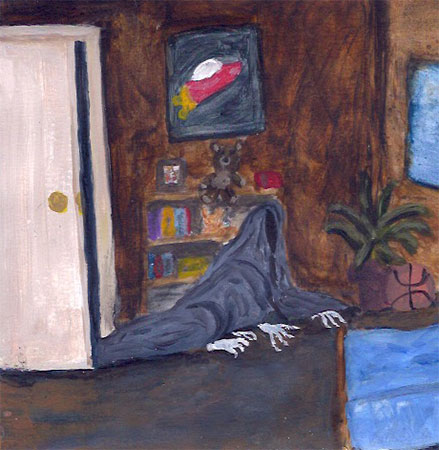
Illustrations “The Boogieman” and “The Monster From the Closet” Copyright Michelle Angelique Duncan.
Angelique Duncan is proprietor of Twilight Faerie Nostalgic and Capricious Objects. Check out her artist page to find links to her shops and vintage inspired traditional holiday art. Visit again next month for more traditions and folklore.
Hazmat Suit Not Required
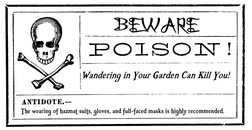
Hazmat Suit Not Required -By Debbi Decker
It all started out innocently. While writing last month’s article about creating a moon garden, I ran across references to this or that plant being poisonous. I read fascinating articles referencing some very famous supposed poisoners. Lucretia Borgia, Agrippina (Nero’s mother), and the goddess, Circe, to name but three. The lovely scented Oleander, which grows almost like a weed in parts of the south, is a deadly plant and one featured in a legend told about the Magnolia Plantation in Louisiana. Ricin, which comes from the castor plant, is one of the most lethal poisons out there and is used to this day. We all love Mistletoe and Poinsettias at Christmas. Intrigued, I decided to do a little research about poisonous plants in our garden. And then I took a look around my own yard and plant choices.
Rhododendron. Check.
Hydrangea. Check.
Hellebores. Check.
Stargazer Lily. Check.
OMG! I’m going to die. I feel itchy, nauseous, dizzy…. Call the doctor! Order the coffin!
Well, that was my first reaction. But, seriously, we can take a step back and look at this realistically. There are numerous popular toxic plants throughout the world that adorn gardens everywhere and yet we see no news reports of masses of people dying after spending time in their gardens. Some people even cultivate these plants on purpose. Alnwick Garden in Northumberland, England comes to mind. There was the famous Medici garden in Padua Italy, and another garden lies behind Blarney Castle in Ireland. In some cases, these were planted specifically as a collection of poisonous plants. In other cases, the gardens gained reputations as being poison gardens simply by association with the legend and lore of the particular gardener or owner. And as a rule, those of us who plant gardens for medicinal uses are always going to have a plant or two that doubles for both healing and harm. Stories abound regarding the Witch or Sorceress who used a common plant found in her garden for healing or for nefarious means.
It was a huge surprise to me, however, just how many plants I own that are truly poisonous, not only to humans but to the various wildlife around me. For instance, I adore Hydrangeas and have one that was given to me many years ago and which has survived several re-plantings as I dug it up to take with me as I moved. The plants contains cyanide. In Japan, one species of the plant is used for tea! Rhododendron, a very popular landscaping bush, is highly toxic to horses and there have been historical reports of people becoming ill after eating honey from bees feeding on the pollen of the flowers. My neighborhood contains hundreds of these bushes. Yikes!!
Another favorite is Hellebore or Lenten Rose. I have masses of these around my home and love them because they bloom in late winter and bring a smile because when they do bloom I know spring is just around the corner. But prolonged skin contact with the seeds can cause rashes and the roots can cause vomiting and diarrhea. In the past, parents would use this plant to help treat worms in their children. Which, according to some of my research, may well have caused death in some of those children. One as to wonder if all of those deaths were innocent.
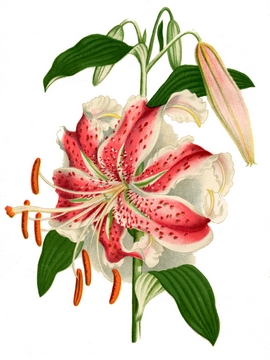
And what about that gorgeous Star Gazer Lily that I have nursed and coddled for years for its exquisite scent and bloom? Yep. Also referred to as “death lily”. Many species of lilies are toxic, such as Lily of the Valley, Rain Lily, and more.
So, what’s a gardener to do? There are even more plants such as Monkshood, Foxglove, and even the lovely Daisy, that can be harmful. Do we don hazmat suits, gloves, and full-face masks whenever we want to do a bit of weeding?
Common sense prevails. While the feel of dirt on bare hands can be therapeutic to some, gardening gloves were probably invented for a reason other than to protect milady’s delicate hands. If you have children or pets, reading up on and identifying the plants in your area is of the utmost importance. I recall our local park gardeners planting the most beautiful lilies I had ever seen and I was anxiously waiting for seeds to form. I had no idea what type of lily it was (though I later found out) but it smelled heavenly and I wanted one. It did not take long for all of those plants to disappear. It seems someone more knowledgeable reported to the authorities that this particular lily was highly poisonous to both humans and animals and therefore not suitable for a public park. What was that lily? Trumpet Lily. I still covet them although I am not in a suitable planting zone to grow them. Research is key. We should all know what is around us to protect ourselves, family and pets. Even those who own no pets and live alone should be aware, because little children are known to wander and the local wildlife can suffer from introduction of a plant not commonly found in their feeding locations.
Common sense also tells us that if we do have these kinds of plants in our gardens, they need to be located far away from any plants or herbs that we harvest for consumption. Imagine the embarrassment (never mind the frownie face the Judge will have) over the passing of Auntie Ludmilla after consumption of that meal you garnished with herbs from your very own garden. We know you did not intend this result. But still….
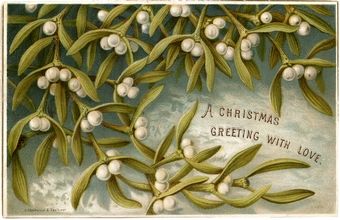
Debbi Decker is proprietor of Crazed Poppet Creations Art & Assemblage Emporium. Check out her artist page to find links to her shop and blog to read more of her writings. Visit again next month for the telling of hauntings and ghostly tales by Debbi Decker.
Archived Featured Artist: The Spiders Parlor
Featured Artist: The Spiders Parlor The natural artistic beauty of real spiders webs captured on canvas and jewelry from Regina A Suarez and her shop The Spiders Parlor
Archived Featured Artist: Posterorama
Featured Artist: Posterorama Limited run poster prints from the masters to the rare and obscure from Liz of Posterorama and buttons of everything one can imagine from her sister shop, Sugar Plum Robots.
Archived Featured Artist: Dee’s Alchemy & Curiosities
Featured Artist: Dee’s Alchemy & Curiosities Occult creations, handcrafted jewelry and rare and curious vintage wares from Dee’s Alchemy & Curiosities.
The Goblins
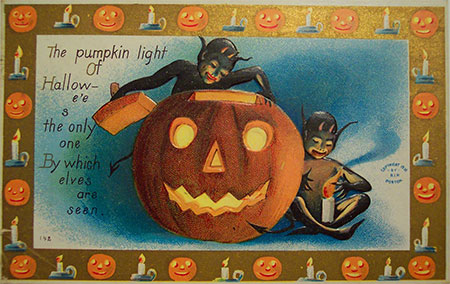
The Goblins-By Angelique Duncan
The Goblins
The Goblins are related to the Brownies and Gnomes of the British Isle. Often they are called Knockers, Kobolds, Bogart, Boogey or Boogey Man interchangeably. Goblins come from the ground and live in marshes, under bridges, abandoned farms and mines. They are the mischievous and sinister cousin species to the benevolent Good Folk, however the Goblins never learned or refused, to live in harmony with mankind.
Goblins have been described differently depending on region and era. Usually they are said to be humanlike and small in nature. Some folklore says they are under a foot tall while others state they are the size of a small child. Often in ancient stories they are said to be hairy with long arms and large feet or distorted features. Sometimes they are described to have hoofed feet and horns or pointed ears. Some say they have large round eyes that are red or yellow. In modern illustrations they are depicted as humanoid, hairless with greenish or grey skin and with devil like features.
Once it was popular belief that Goblins inhabited caves and mines. Some stories tell that the Goblins would knock to warn the working miners of cave-ins or poisonous gases. However some folklore suggests the opposite, that the Goblins would cause the mines to cave and that they were actually responsible for creating the poisonous gases to get rid of the humans so they could keep resources for themselves.
Folklore surrounding the Goblins states that they are responsible for abducting travelers on dark roads and for stealing pets and children, especially around Halloween. Some believe that Goblins looking for a new dwelling would follow people and take over their homes.
It is said that one should never invite one into your home or adopt a Goblins company. They are destructive creatures that cause misery and ill fortune. Goblins are the ones who make things go wrong. If you find sand in your bed, milk that sours too soon, knocked over things, pulled up plants from the garden, untied shoes and stained linens regularly in your home; you may have a Goblin.
At night Goblins will torment the people they have attached to by pulling the sheets off the bed and rearranging pillows. They have been reported to pinch or poke people while they are sleeping. Other tactics of the Goblins is to put cold hands on people’s feet, tug on their ears or nose or slap ones face while one sleeps.
Their behavior can escalate beyond acts of inconvenient mischief, to acts of terror. Goblins have been said to steal or endanger livestock and ruin crops. They cause harm to small animals and can make them disappear. Goblins are known as thieves and can bring financial ruin. Once it was believed that when a horse gets skittish and spooked or if a dog growls or barks when nothing seems to be there, the animals are aware that a Goblin is present.
Once a home is invested with a Goblin they can be near impossible to get rid of. Goblins are said to follow a family or individual if they attempt to abandon it, often increasing their acts of ill intent out of anger. Popular deterrents to prevent Goblins from entering the home are to hang a horseshoe over ones door or to keep a bowl of salt next to the door. One must be careful to never allow their shoes to lie upside down, as this invites Goblins to your home. Many folklores state the only way to rid oneself of a Goblin is to either outwit them by extreme trickery or by ultimately killing it. Be very careful when traveling near abandoned buildings, bridges or caves. Pay attention when your dog seems to bark randomly. Goblins may be near.
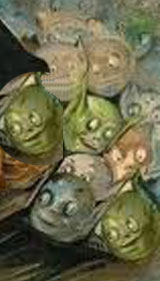
Angelique Duncan is proprietor of Twilight Faerie Nostalgic and Capricious Objects. Check out her artist page to find links to her shops and vintage inspired traditional holiday art. Visit again next month for more traditions and folklore.
Along a Moonlit Path
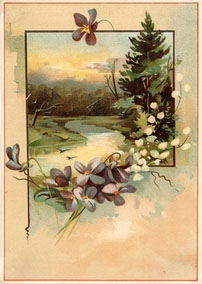
Along a Moonlit Path -By Debbi Decker
April brings thoughts of gardening. Spring has finally arrived and although there are still chances of cool nights, the days are longer and the sun is warmer. We spend time in the local nurseries picking out plants to put in our gardens and yards. After a long gray winter, we want color and we want it now.
Or do we? Some of us are not day people. We travel the nights and find our beds just after sunrise. While we are not vampires (at least most of us are not), we just prefer the darkness. Trouble is, that those of us night people who love flowers and plants miss the beauty of the gardens during the day. The vibrant floral colors fade away as the night falls.
We can fix that, however. By planting a moon garden. Imagine walking through a garden of highly scented flowers that glow in the moonlight. Intrigued?
All you need is an area that gets full sun to part shade, plants that are mostly white or silvery in nature, and also plants whose blossoms open as the sun goes down releasing their fragrance. If some illumination is necessary for walking safety, use lighting that is subtle and low key. White gravel will glow on pathways. Sketch out a plan so that you have an idea of the finished garden. Choose plants that will do well in your planting zone and know which ones will need to come indoors when the weather turns cold. Some plants are actually bushy while others hug the ground. You will want plants of various heights, as well as non-blooming leafy plants such as hostas and ferns, to create visual interest for both day and night. Colorful flowers that open at night to release their fragrance can be used at the ends of your moon garden or planted on their own in another area. Be sure to create a spot where you can simply sit and enjoy the fragrances on the night air.
Choose one or two of the below plants, fill in with flowers such as white candytuft, white or pale pink impatiens, lamb’s ears, white lilies and other plants that bloom white or in pale colors. Be sure to have plants with staggered bloom times so that you have something in your garden blooming from late spring through fall. Add some subtle lighting, a scattering of statues or other ornamentation, and you are on your way to magical nights full of moon-lit beauty and intoxicating scents.
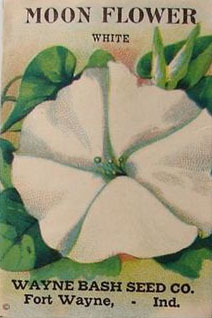
Night Jasmine (Cestrum nocturnum) Narrow tubular blossoms open at night and release fragrance.
Angel Trumpet (Brugmansia) Large white trumpet shaped blossoms also open at night and release fragrance.
Evening Primrose (Oenothera biennis L.) While this flower is yellow, it opens in the evening and stays open until late morning.
Four O’Clocks (Mirabilis jalapa) Colorful flowers that open in the late afternoon and release their fragrance in the evening.
Moonflowers (Datura) Large white blossoms that resemble their sister morning glories but which open at night and release their fragrance.
A word of caution. All of the above plants are toxic and/or poisonous if ingested, and some can cause skin irritation. Always do your research and know what you are planting. Monitor children and pets in the garden, and warn your guests of the nature of your plants. It’s never a good idea for someone to accidentally ingest a berry or touch a noxious plant and then expire in the middle of all that glowing beauty . Unless, that is, your name is Lucrezia Borgia.
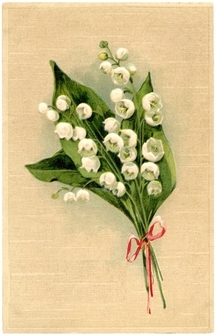
Debbi Decker is proprietor of Crazed Poppet Creations Art & Assemblage Emporium. Check out her artist page to find links to her shop and blog to read more of her writings. Visit again next month for the telling of hauntings and ghostly tales by Debbi Decker.

 Art By Sarada on HAB
Art By Sarada on HAB Chad Savage on Etsy
Chad Savage on Etsy Jans Beads on HAB
Jans Beads on HAB Ravens Bend Folk Art on Etsy
Ravens Bend Folk Art on Etsy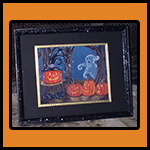 Twilight Faerie on HAB
Twilight Faerie on HAB Sauvage Raven Creations HAB
Sauvage Raven Creations HAB  Wicked Altereations on HAB
Wicked Altereations on HAB A Paper Witch on Etsy
A Paper Witch on Etsy Ashley Anonymous on Etsy
Ashley Anonymous on Etsy Jynxx Designs on Etsy
Jynxx Designs on Etsy Chaos In Color Website
Chaos In Color Website  Ghostgap On HAB
Ghostgap On HAB A.Ryer Studio on HAB
A.Ryer Studio on HAB Plum Batty on Etsy
Plum Batty on Etsy The Felted Fey on Etsy
The Felted Fey on Etsy